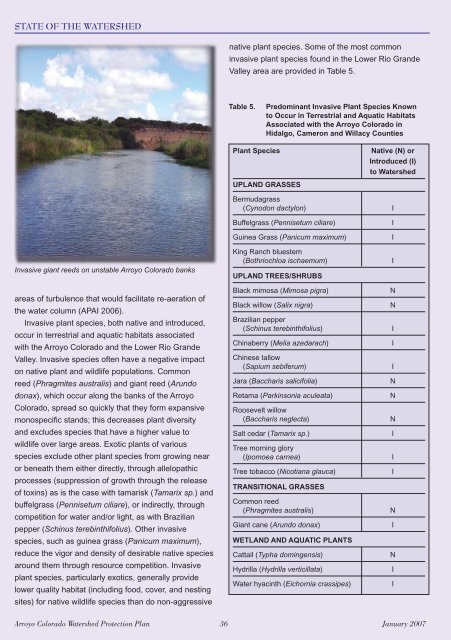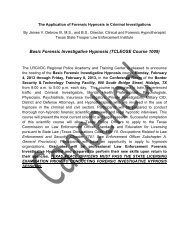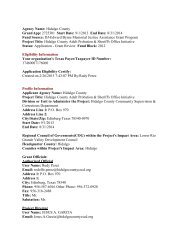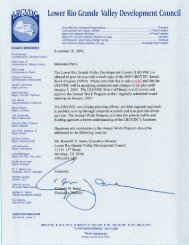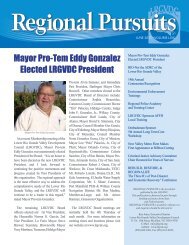Watershed Protection Plan - Lower Rio Grande Valley Development ...
Watershed Protection Plan - Lower Rio Grande Valley Development ...
Watershed Protection Plan - Lower Rio Grande Valley Development ...
Create successful ePaper yourself
Turn your PDF publications into a flip-book with our unique Google optimized e-Paper software.
STATE OF THE WATERSHED<br />
native plant species. Some of the most common<br />
invasive plant species found in the <strong>Lower</strong> <strong>Rio</strong> <strong>Grande</strong><br />
<strong>Valley</strong> area are provided in Table 5.<br />
Table 5.<br />
Predominant Invasive <strong>Plan</strong>t Species Known<br />
to Occur in Terrestrial and Aquatic Habitats<br />
Associated with the Arroyo Colorado in<br />
Hidalgo, Cameron and Willacy Counties<br />
Invasive giant reeds on unstable Arroyo Colorado banks<br />
areas of turbulence that would facilitate re-aeration of<br />
the water column (APAI 2006).<br />
Invasive plant species, both native and introduced,<br />
occur in terrestrial and aquatic habitats associated<br />
with the Arroyo Colorado and the <strong>Lower</strong> <strong>Rio</strong> <strong>Grande</strong><br />
<strong>Valley</strong>. Invasive species often have a negative impact<br />
on native plant and wildlife populations. Common<br />
reed (Phragmites australis) and giant reed (Arundo<br />
donax), which occur along the banks of the Arroyo<br />
Colorado, spread so quickly that they form expansive<br />
monospecifi c stands; this decreases plant diversity<br />
and excludes species that have a higher value to<br />
wildlife over large areas. Exotic plants of various<br />
species exclude other plant species from growing near<br />
or beneath them either directly, through allelopathic<br />
processes (suppression of growth through the release<br />
of toxins) as is the case with tamarisk (Tamarix sp.) and<br />
buffelgrass (Pennisetum ciliare), or indirectly, through<br />
competition for water and/or light, as with Brazilian<br />
pepper (Schinus terebinthifolius). Other invasive<br />
species, such as guinea grass (Panicum maximum),<br />
reduce the vigor and density of desirable native species<br />
around them through resource competition. Invasive<br />
plant species, particularly exotics, generally provide<br />
lower quality habitat (including food, cover, and nesting<br />
sites) for native wildlife species than do non-aggressive<br />
<strong>Plan</strong>t Species<br />
UPLAND GRASSES<br />
Bermudagrass<br />
(Cynodon dactylon)<br />
Buffelgrass (Pennisetum ciliare)<br />
Guinea Grass (Panicum maximum)<br />
King Ranch bluestem<br />
(Bothriochloa ischaemum)<br />
UPLAND TREES/SHRUBS<br />
Black mimosa (Mimosa pigra)<br />
Black willow (Salix nigra)<br />
Brazilian pepper<br />
(Schinus terebinthifolius)<br />
Chinaberry (Melia azedarach)<br />
Chinese tallow<br />
(Sapium sebiferum)<br />
Jara (Baccharis salicifolia)<br />
Retama (Parkinsonia aculeata)<br />
Roosevelt willow<br />
(Baccharis neglecta)<br />
Salt cedar (Tamarix sp.)<br />
Tree morning glory<br />
(Ipomoea carnea)<br />
Tree tobacco (Nicotiana glauca)<br />
TRANSITIONAL GRASSES<br />
Common reed<br />
(Phragmites australis)<br />
Giant cane (Arundo donax)<br />
WETLAND AND AQUATIC PLANTS<br />
Cattail (Typha domingensis)<br />
Hydrilla (Hydrilla verticillata)<br />
Water hyacinth (Eichornia crassipes)<br />
Native (N) or<br />
Introduced (I)<br />
to <strong>Watershed</strong><br />
I<br />
I<br />
I<br />
I<br />
N<br />
N<br />
I<br />
I<br />
I<br />
N<br />
N<br />
N<br />
I<br />
I<br />
I<br />
N<br />
I<br />
N<br />
I<br />
I<br />
Arroyo Colorado <strong>Watershed</strong> <strong>Protection</strong> <strong>Plan</strong> 36 January 2007


